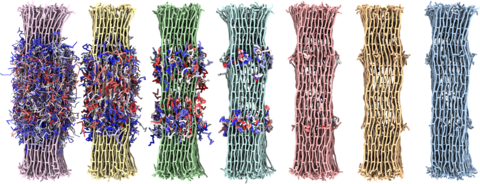Trapping of protein cargo molecules inside DNA origami nanocages

The development of the DNA origami technique has directly inspired the idea of using three-dimensional DNA cages for the encapsulation and targeted delivery of drug or cargo molecules. The cages would be filled with molecules that would be released at a site of interest upon cage opening triggered by an external stimulus. Though different cage variants have been developed, efficient loading of DNA cages with freely-diffusing cargo molecules that are not attached to the DNA nanostructure and their efficient retention within the cages has not been presented. Here we address these challenges using DNA origami nanotubes formed by a double-layer of DNA helices that can be sealed with tight DNA lids at their ends. In a first step we attach DNA-conjugated cargo proteins to complementary target strands inside the DNA tubes. After tube sealing, the cargo molecules are released inside the cavity using toehold-mediated strand displacement by externally added invader strands. We show that DNA invaders are rapidly entering the cages through their DNA walls. Retention of ∼70 kDa protein cargo molecules inside the cages was, however, poor. Guided by coarse-grained simulations of the DNA cage dynamics, a tighter sealing of the DNA tubes was developed which greatly reduced the undesired escape of cargo proteins. These improved DNA nanocages allow for efficient encapsulation of medium-sized cargo molecules while remaining accessible to small molecules that can be used to trigger reactions, including a controlled release of the cargo via nanocage opening.